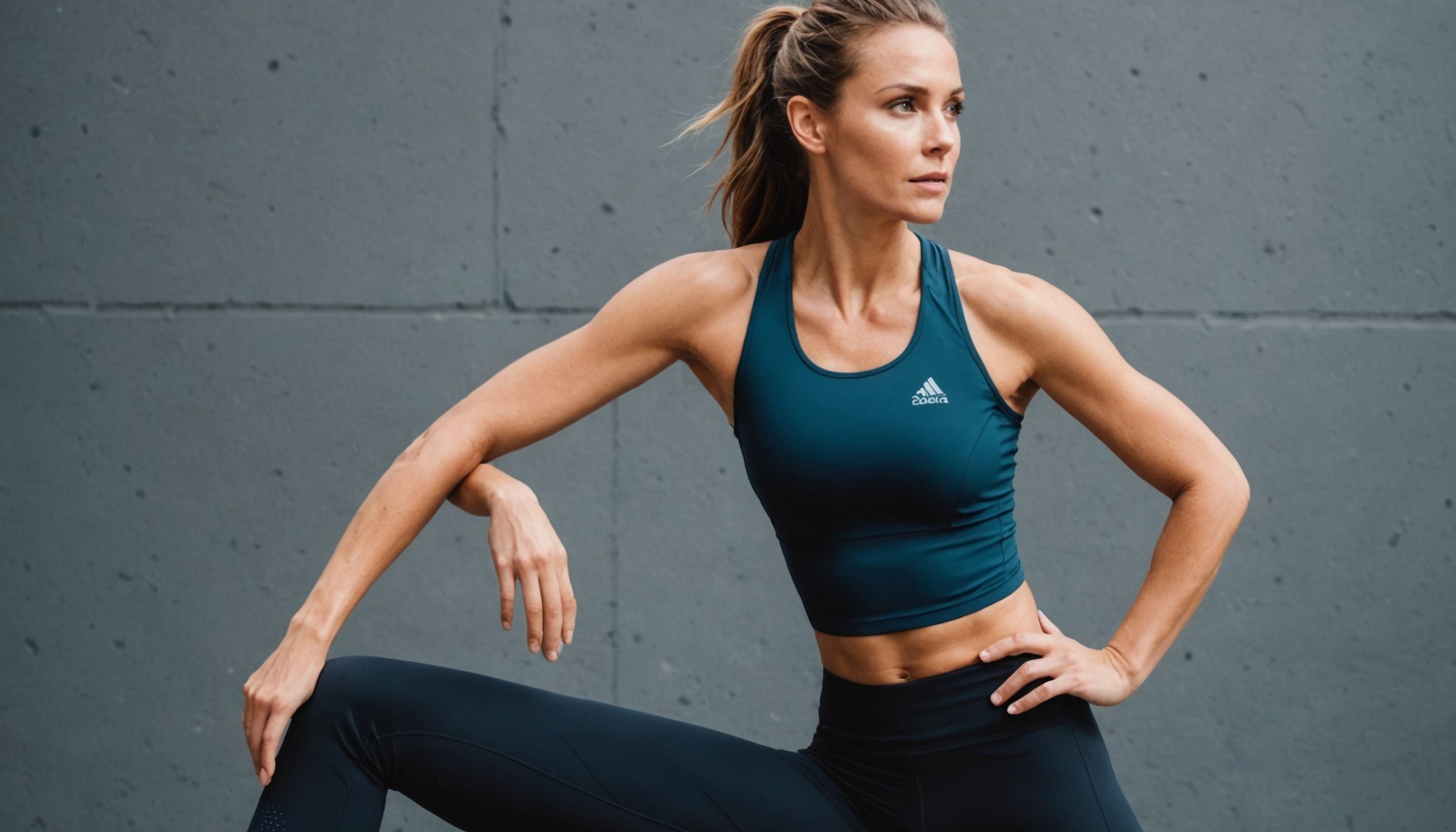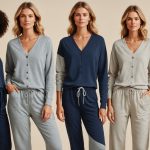Overview of Eco-Friendly Activewear Fabrics
Activewear has transformed with the advent of eco-friendly activewear fabrics, a breakthrough catering to fitness enthusiasts conscientious about their environmental footprint. These sustainable fabrics not only embody a green lifestyle but also offer numerous benefits.
Eco-friendly activewear is crafted from materials that have a reduced environmental impact compared to conventional fabrics. This includes recycled textiles, organic fibers, and other forms of sustainable fabrics. The use of these materials significantly lessens the strain on natural resources and minimizes the ecological disruptions typically associated with fabric production.
Have you seen this : Discover the Top Sustainable Fashion Brands in the UK: Your Ultimate Guide to Eco-Friendly Style!
There are several popular materials used in eco-friendly activewear. Organic cotton, bamboo, and recycled polyester are among the well-accepted choices, widely celebrated for their durability and minimal environmental impact. Bamboo, for instance, grows rapidly without the need for pesticides, making it an excellent choice for fitness apparel.
The benefits extend beyond environmental well-being. Choosing sustainable fabrics supports reduced chemical exposure, making these materials gentler on the skin, while contributing to a healthier lifestyle. In conclusion, embracing eco-friendly activewear enhances not just the wardrobe, but also supports a conscientious approach to health and environmental care.
This might interest you : Discover the Ultimate Trendy and Comfortable Urban Cycling Gear in the UK
Top Sustainable Activewear Brands in the UK
When seeking eco-friendly activewear, the UK offers a variety of sustainable brands dedicated to environmentally conscious fitness apparel. These brands ensure their products align with sustainability goals, providing choices that merge style with ecological mindfulness. One such brand is Patagonia, renowned for its commitment to using recycled materials and ethical manufacturing processes. This brand doesn’t just stop at crafting apparel but actively supports environmental initiatives, setting a benchmark for others.
BAM Bamboo Clothing is another standout, leveraging bamboo fabric for its unique blend of durability, comfort, and sustainability. Emphasizing transparency, BAM offers insights into each garment’s environmental impact, encouraging informed consumer choices.
Presca, the UK’s pioneering circular sportswear brand, innovates by creating fully recyclable activewear, enhancing its environmental benefits. Their products are designed to extend beyond the typical lifecycle of activewear, removing waste at the end of their usable life.
These brands create options not only for a sustainable lifestyle but also facilitate conscious consumerism. By focusing on sustainable practices, these UK brands present high-quality, eco-friendly apparel options that reflect a genuine commitment to the planet.
Benefits of Choosing Sustainable Activewear
In the pursuit of a healthier, eco-friendly lifestyle, sustainable fabrics in activewear offer undeniable advantages. These choices not only minimise environmental impact but enhance well-being.
Environmental Benefits
Choosing sustainable activewear significantly reduces the carbon footprint. By utilising materials like recycled polyester and organic cotton, the demand for new resources decreases, conserving energy and water. This shift diminishes pollution from manufacturing processes, supporting ecological balance.
Health Benefits
Eco-friendly activewear also extends health benefits. Using sustainable fabrics often results in fewer chemicals coming into contact with the skin, reducing the risk of irritation and allergies. This is particularly beneficial for those with sensitive skin, promoting a more comfortable workout experience.
Long-term Cost Efficiency
Investing in high-quality, sustainable activewear can be cost-efficient over time. These products tend to be more durable and long-lasting, reducing the need for frequent replacements. While initial costs might be higher, the longevity and resilience of eco-friendly fitness apparel lead to savings in the long run.
Overall, the adoption of sustainable practices in the selection of activewear supports a conscientious lifestyle, aligning personal health with environmental stewardship.
Types of Eco-Friendly Fabrics
Eco-friendly activewear entails using sustainable materials that cater to both fitness and environmental needs. The focus on sustainability has seen a shift towards innovative fabric options that reduce harm to our planet while meeting the demands of activewear. Several noteworthy types of eco-friendly fabrics have emerged, each with unique advantages.
Organic Cotton
Organic cotton stands out for its sustainable properties. Unlike traditional cotton, it’s grown without harmful pesticides and synthetic fertilizers, reducing soil and water contamination. The fabric is soft, breathable, and gentle on the skin, making it an excellent choice for activewear types. However, the production process is more resource-intensive, potentially leading to higher prices.
Recycled Polyester
Recycling polyester is an energy-efficient process that captures the benefits of traditional polyester while minimizing environmental impact. This fabric option repurposes existing plastic waste, transforming it into durable, moisture-wicking activewear. While it reduces landfill waste, its end-of-life recyclability remains a challenge.
Bamboo Fabric
Bamboo fabric is gaining popularity due to its rapid growth rate and minimal agricultural input. It is naturally breathable and antimicrobial, providing great comfort and freshness in activewear. Despite these benefits, the chemical processes in its manufacturing can be a downside, highlighting the importance of choosing consciously sourced bamboo.
How to Choose Eco-Friendly Activewear
Navigating the world of eco-friendly activewear can seem daunting, but with a bit of insight, selecting the ideal pieces becomes straightforward. Understanding the nuances of sustainable fabrics enhances both your wardrobe and your commitment to the environment.
Quality vs. Price
When choosing sustainable activewear, balance quality with cost. While eco-friendly options might come with a higher initial price, consider the long-term value. Higher-quality fitness apparel often translates to increased durability, reducing the need for frequent replacements. Prioritise materials known for their longevity, like organic cotton, which, despite its initial resource intensity, offers durability and comfort.
Fabric Certifications
Fabric certifications serve as trusted indicators of sustainability. Look for labels like Global Organic Textile Standard (GOTS) when evaluating sustainable fabrics. These certifications ensure ethical practices in fabric production, guaranteeing reduced environmental impact and better working conditions.
Brand Transparency
Transparency is a hallmark of brands committed to sustainability. Prioritise companies that openly disclose their sourcing, manufacturing practices, and environmental impact of their fitness apparel. Insightful disclosures promote informed decision-making, ensuring your activewear choices support ethical practices. Brands that provide extensive transparency, like BAM, foster trust and bolster consumer confidence.
The Environmental Impact of Activewear
Understanding the environmental impact of activewear is crucial for those aiming to make eco-friendly choices. Traditional fabrics often rely on non-renewable resources, resulting in substantial environmental challenges due to pollution and resource depletion. These materials typically have a high carbon footprint throughout their lifecycle—from production and transportation to disposal—posing significant threats to ecosystems.
The activewear industry confronts several obstacles in adopting sustainable practices. These include transitioning to renewable energy sources, reforming waste management, and innovating eco-friendly alternatives. Yet, there are promising advancements. Recycled materials, bioplastics, and plant-based fibres are emerging as viable options, aiming to counteract harmful impacts.
Moreover, manufacturing processes are evolving. Brands increasingly adopt closed-loop systems and water-efficient technologies, significantly reducing waste and emissions. These innovative strategies not only lessen impact but also reflect a commitment to environmental sustainability.
Consumers, too, play a pivotal role. Supporting brands that prioritize eco-friendly practices enables a shift towards a more sustainable activewear market. By choosing products with lower environmental impact, individuals can contribute significantly to reducing the industry’s ecological footprint while encouraging more brands to embrace sustainability challenges.
Visuals and Case Studies
Exploring eco-friendly activewear through real-world examples can offer valuable insights into sustainable practices. Case studies can highlight how brands successfully integrate sustainable fabrics into their fitness apparel, creating both environmental and consumer benefits.
One noteworthy example is the use of recycled polyester by Patagonia. This brand showcases its commitment to reducing waste by repurposing plastic bottles into durable activewear. This practice not only illustrates the potential of sustainable materials to replace traditional polyester but also showcases a broader commitment to environmental stewardship.
Visual elements, such as product visuals, effectively communicate the practicality and style of eco-friendly apparel. Charts displaying fabric usage can be instrumental in demonstrating how sustainable choices support ecological objectives, comparing the lifecycle benefits of materials like bamboo, organic cotton, and recycled polyester.
Brands like Presca emphasize this connection by designing compelling visuals that represent their fully recyclable activewear. Such imagery connects consumers with the tangible benefits of choosing eco-friendly options.
These case studies and visuals serve as powerful tools in understanding the impact of sustainable activewear. They not only showcase the benefits of sustainable fabrics but also motivate consumers to make informed, environmentally conscious decisions.






